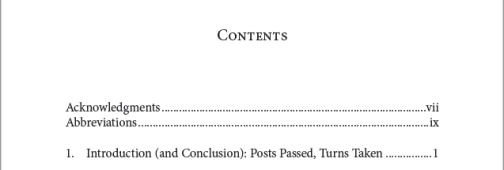Although not every work needs a list of abbreviations, it is often advisable to include such a list at the beginning of monographs and edited collections, even if one is following the SBL Handbook of Style. This allows a reader quickly to discern the meaning of a given abbreviation without consulting another source that may not be readily at hand. This post details some considerations for creating an abbreviations list.
1. Placement
When included, an abbreviations list is placed in the front matter of a volume, after the table of contents and any preface/acknowledgments page. The location of the abbreviations list should be noted in the table of contents with the simple title “Abbreviations.”
Example 1:

Example 2:

2. Abbreviations
An abbreviations list should include all ancient sources; modern journals, dictionaries, lexica, encyclopedias, and series; grammatical abbreviations (e.g., abl. ablative); and technical sigla (e.g., > omits the lemma). One may omit abbreviations of biblical books if the intended reader will likely be familiar with the abbreviations.
3. Divisions
Typically it is sufficient to place abbreviations in a single list. However, when the list is extensive, it can be helpful to subdivide the abbreviations list into sections. Some commonly used subdivisions include:
Ancient Sources
Secondary Sources
Sigla
4. Format
The final format of the abbreviations page will be determined by the publisher. SBL Press recommends that, unless you are instructed otherwise, format the abbreviations list into two columns separated by a single tab. This will make it easy for the publisher to convert the format of the abbreviations list into the preferred style.
| AB | Anchor Bible |
| ABD | Freedman, David Noel, ed. Anchor Bible Dictionary. 6 vols. New York: Doubleday, 1992. |
| Abr. | Philo, De Abrahamo |
| Agr. | Philo, De agricultura |
| AJSL | American Journal of Semitic Languages and Literature |
| Ann. | Granius Licinianus, Annales; Tacitus, Annales |
| Atlantis | Atlantis: Journal of the Spanish Association of Anglo-American Studies |
| AzTh | Arbeiten zur Theologie |
| BibInt | Biblical Interpretation |
| BibInt | Biblical Interpretation Series |
| BSac | Bibliotheca Sacra |
A few items to note:
* Abbreviations and titles are italicized or roman according to their usage elsewhere.
* In attributed ancient works, the ancient author name should precede the title in the second column only.
Discouraged:
| Abr. | De Abrahamo, Philo |
| Philo, Abr. | De Abrahamo |
Recommended:
| Abr. | Philo, De Abrahamo |
* If the same abbreviation is used for more than one ancient source, include both sources on the same line.
Discouraged:
| Ann. | Granius Licinianus, Annales |
| Ann. | Tacitus, Annales |
Recommended:
| Ann. | Granius Licinianus, Annales; Tacitus, Annales |
* Journals and series include the title only. Do not include information about the publisher.
Discouraged:
| JSOTSup | Journal for the Study of the Old Testament Supplement Series. London-Sheffield, 1980– |
Recommended:
| JSOTSup | Journal for the Study of the Old Testament Supplement Series |
* Encyclopedias, lexica, and similar reference works should include the full bibliographic information in the same form as it would appear in a bibliography, beginning with the last name(s) of the author(s) or editor(s).
Discouraged:
| ABD | Anchor Bible Dictionary |
| ABD | Anchor Bible Dictionary. Edited by David Noel Freedman. 6 vols. New York: Doubleday, 1992. |
Recommended:
| ABD | Freedman, David Noel, ed. Anchor Bible Dictionary. 6 vols. New York: Doubleday, 1992. |
* Tip: Align the second column of the abbreviations list using Word’s built-in ruler rather than inserting spaces or extra tabs. For more information on how to use Word’s built-in ruler to align text, see here.
5. Alphabetization
Alphabetize the list by abbreviations following the same alphabetization rules that are used for indices (see SBLHS §7.2). Proceed character by character using the following hierarchy:
[Space]
’ [apostrophe]
0
1
(etc.)
9
a, A, ä, á, å (etc.)
b
(etc.)
z
Ignore: hyphens, en dashes, periods, and double and single quotation marks.
So, for example,
| 1 Apol. | Justin Martyr, First Apology |
| 1 En. | 1 Enoch |
| 1QM | War Scroll |
| 4QpNah | Pesher Nahum |
| Ab urbe cond. | Livy, Ab urbe condita |
| Agr. | Cicero, De lege agraria |
| Ant. | Plutarch, Antonius |
| Ant. rom. | Dionysius of Halicarnassus, Antiquitates romanae |
Greek, Hebrew, and other foreign characters should be placed where they will most benefit the reader. For instance, θ’ (signifying Theodotion’s Greek translation of the Hebrew Bible) can be located immediately after the numbers (e.g., after 4QpNah above) or with the th entries.
6. Authorities for Abbreviations
Additional information about specific abbreviations can be found in the SBLHS §8 and throughout this blog. For abbreviations we do not list, see Siegfried M. Schwertner, Internationales Abkürzungsverzeichnis für Theologie und Grenzgebiete, 3rd ed. (Berlin: de Gruyter, 2014).